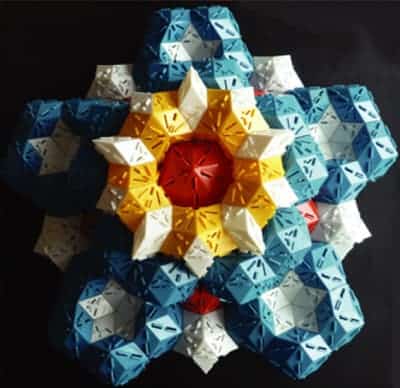Brownian motion melts a quasicrystal of tiny Penrose tiles
04 Sep 2018
A quasicrystal made from tiny Penrose tiles that undergo Brownian motion has been created by Po-Yuan Wang and Thomas Mason at the University of California-Los Angeles. The duo was able to track changes in the 2D structure as tiles moved around, observing a range of effects including melting. As well as shedding further light on the properties of quasicrystals, the new lithographic fabrication technique could be used to study a wide range of colloidal systems.
The unexpected discovery of quasicrystalline materials was made in 1984 by the Israeli materials engineer Dan Shechtman, who was later awarded the 2011 Nobel Prize for Chemistry. Although the discovery was first met with scepticism, hundreds of solid-state quasicrystals have since been discovered. Furthermore, researchers are looking at potential applications of quasicrystals that range from aerospace to coatings of surgical and kitchen utensils.Until relatively recently, scientists had assumed that all crystals have translational symmetry. This means they comprise a periodically-repeating unit cell of atoms that fills space without any voids. In contrast, quasicrystals do not have translational symmetry – they possess rotational symmetry – but also fill space without any voids.
Much more to learn
Quasicrystals have also been observed in several types of soft matter including colloids and dendrimers. However, after 34 years of research and over 11,000 publications on quasicrystals there is still much more to learn about these materials.
In their study, Wang and Mason created a “Penrose P2” quasicrystalline 2D metamaterial using two types of plastic tiles each measuring about 10 µm in size. These kite- and dart-shaped tiles were designed by a computer-aided method and lithographically printed onto a glass wafer covered with a thin 10 nm layer of a solid lift-off release material that functions like a temporary glue. Unlike the original Penrose P2 tiling – in which the tiles are packed tightly together – the practicalities of lithographic production meant that gaps were left between the tiles. The release material dissolves upon addition of a chemical solution, freeing the tiles from the glass wafer so they are free to move on the glass surface.
Before release, the dart- and kite-tiles are arranged into local motifs that are in turn arranged into various superstructural patterns. After release, Brownian motion causes the orientation and position of the tiles to change as they become free to move. Wang and Mason were then able to observe the structure of the quasicrystal as it fluctuated. This study revealed a range of interesting behaviours before the quasicrystal “melted” to resemble a liquid as the tile density decreased. At certain densities on the way to melting, for example, the system creates a “pentatic liquid quasi-crystal” – which is an exotic phase of matter that has not been previously seen.
Circumventing self-assembly
Creating these lithographically pre-assembled monolayers (litho-PAMs) of tiles differs from techniques for making self-assembled monolayers (SAMs). One of the big goals in self-assembly has been the creation of a five-fold symmetric quasicrystal over large areas. The litho-PAMs method circumvents the self-assembly step and this opens many viable routes to different tile sizes and shapes, including the potential to expand to 3D materials.
“New applications of the litho-PAMs method will allow researchers to study of other forms of matter– not only quasicrystals, but also other types of multi-scale materials that have different structures at different length scales,” says Mason. He adds, “This method opens the door for studying all these systems without having to solve the problem of encoding interactions between particles to create the system in the first place. Our new method enables experimentalists to jump beyond self-assembly in terms of making new 2D Brownian tile systems and exploring them, possibly even before theorists can dream them up.”READ MORE

Ronan McGrath of the University of Liverpool told Physics World, “this work represents a very interesting and original addition to the small but growing number of fabricated quasicrystalline metamaterials”. He adds, “The work differs from previous colloidal approaches in that the quasicrystalline structure is pre-assembled through an ingenious lithographic process. This allows the study of the temporal evolution of the quasicrystalline pattern under Brownian motion with and without hard-wall constraints.”
“It will be especially interesting to see if the approach can be extended to three dimensional structures which would complement more established colloidal self-assembly protocols,” says McGrath.
The research is reported in Nature.
Martina Ribar Hestericová is a science writer based in Switzerland
5/9/2018 FROM PHYSICSWORLD.COM
 Moving pictures: microscope image of a quasicrystal two days after release. The right half has been colour coded. (Courtesy: Po-Yuan Wang and Thomas Mason/Nature)
Moving pictures: microscope image of a quasicrystal two days after release. The right half has been colour coded. (Courtesy: Po-Yuan Wang and Thomas Mason/Nature)
Δεν υπάρχουν σχόλια:
Δημοσίευση σχολίου